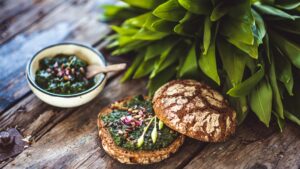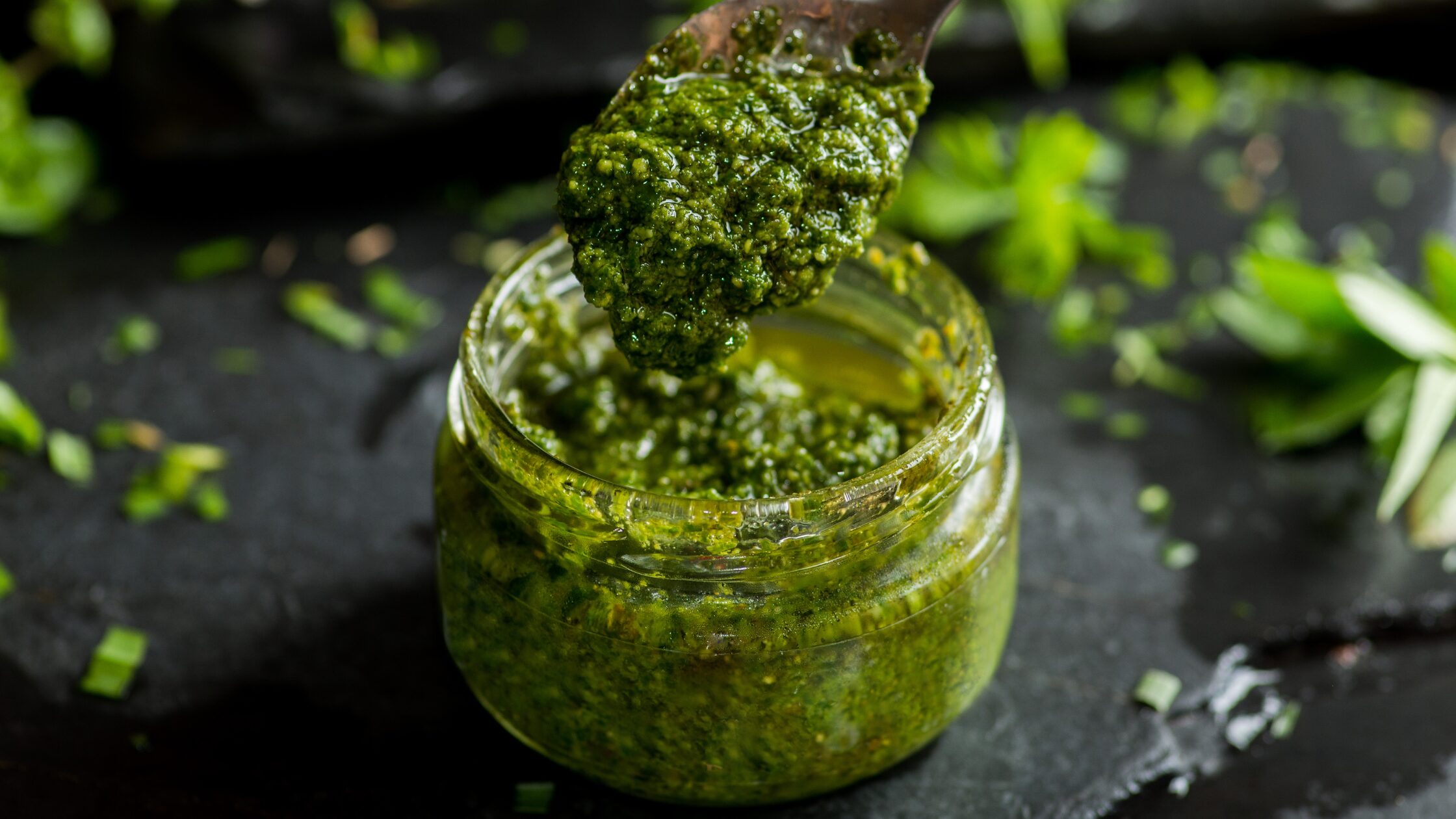.
Aficionados of pasta and fresh vegetables appreciate the fresh and aromatic flavour of pesto. If you have fresh herbs at hand you can make some delicious herb pesto with simple means and relatively few ingredients. The big advantage compared to the store-bought version is that you can decide what herbs to put in and adjust the flavour to your liking. Below I’ll show you three great recipes for different herbal pesto that you can make in almost no time.
Tips for making pesto
Making herbal pesto is a fast and easy way to process fresh herbs.
Necessary devices
Pesto recipes always recommend using pestle and mortar. The reason behind this is not to make your arms go lame during the process of shredding and mixing the ingredients but to keep the herbs’ essential oils from evaporating. Electric devices like kitchen blenders or mixers can destroy valuable aroma substances of the herbs. Some essential oils evaporate at 40 °C already and the mentioned devices can reach those temperatures in a relatively short time. Thus, using a pestle and mortar is the first choice for making pesto.
However! If you chop the ingredients into very small pieces, use the pulsing function of your hand blender and pause the device whenever it gets warm, you’ll also get a formidable pesto. The choice of device is up to you.
What you should do in any case is wash the herbs and dry them thoroughly, then chop them finely with a knife before putting them either into the mortar or bowl for further processing.
Basic pesto ingredients
For an aromatic pesto, you always need two main ingredients: oil- or fat-containing nuts or seeds and an appropriate plant oil. One of the most famous recipes for a classic pesto, the Pesto alla Genovese, uses pine nuts and high-quality cold-pressed olive oil.
You can experiment like a crazy scientist with the nuts and seeds. Try out walnuts, for instance, or pistachios, hazelnuts, almonds, sunflower or pumpkin seeds, cashew nuts or – as in the original – pine nuts. Apart from olive oil, you can use sunflower oil, pumpkin seed oil or walnut oil. There is (almost) no limit to the imagination!
A further important ingredient is well-matured aromatic hard cheese – at least for all non-vegans. You can either use pecorino cheese which is mostly made of sheep milk or a good parmesan. Or both.
The last basic ingredient for our herb pesto is – tadaa! – herbs. You can use almost all herbs. If you use a mix of herbs, make sure that they harmonize well. When in doubt, stick to the classic Mediterraneans like rosemary, sage, thyme, savoury, basil and oregano. Either use the single herbs or a combination.
Further possibilities are kitchen herbs like lovage, bear’s garlic, parsley and tarragon or wild herbs like dandelion, sorrel or goutweed.
Recipes for homemade herb pesto
It’s quite easy to make herb pesto by yourself. In a few easy steps, you can make some tasty variations that are great in Italian dishes, on fresh bread or as salad dressing. I show you some simple recipes that you can adapt to your liking.
Bear’s garlic pesto
Bear’s garlic or wild garlic is a very popular spring herb. You may have tried already these recipes for bear’s garlic bread and bear’s garlic brioche braids. Wild garlic pesto is another great recipe for this flavoury herb. Its delicious taste is wonderful with pasta and fried potatoes. You can use it in a risotto or spread it on freshly baked rustic bread.

Ingredients for 250 ml pesto
50 g bear’s garlic
125 ml olive oil
5 walnuts
50 g pecorino
½ tsp salt
Instructions
Wash the wild garlic leaves and chop them finely. Grind the walnuts with a pestle in the mortar until they’re creamy, then add the chopped wild garlic. Add the pecorino. Alternatively, put all the ingredients into a bowl and mix them with a blender. Remember to only pulse the blender. Add the oil and salt to your taste.
Mediterranean herb pesto (vegan)
Combine Mediterranean herbs like thyme, lavender, basil, oregano, savory, rosemary and sage and use it for an extraordinary vegan herb pesto. A bit of garlic enhances the flavour of the herb mix.
Ingredients for 250 g pesto
10 g thyme
10 g lavender
15 g basil
15 g oregano
1 – 2 garlic cloves
20 g pine nuts
125 ml olive oil
1 tsp of salt and pepper each
Instructions
Chop the herbs and the garlic. Roast the pine nuts without oil in a pan until they turn light brown. Put the nuts and the chopped herbs in a mortar and mash them together with a pestle. Add the oil and salt and mix all thoroughly. If you want – and don’t insist on this pesto variant being vegan – you can also add hard cheese, for example, parmesan.
Wild herb pesto with dandelion, sorrel and goutweed
Wild herb lovers will adore this pesto that’s perfect for noodles, gnocchi or wild herb salads.

Ingredients for 250 ml wild herb pesto
50 g wild herbs (dandelion, sorrel and goutweed)
25 g sunflower seeds
10 g walnuts
125 ml olive oil (alternative: grape seed oil)
2 tsp lime juice (alternative: lemon juice)
2 tbsp parmesan
1/2 – 1 tsp salt
1/2 – 1 tsp pepper
Instructions
Wash the fresh herbs thoroughly, then dry and chop them. Put the sunflower seeds, walnuts and chopped herbs into a mortar and mash all together with a pestle. After that, add the oil, lime juice and cheese and mix it all thoroughly. Add salt and pepper to your taste.
Storage time of homemade pesto
Making herb pesto is a fast process and you may be tempted to make a lot of it when your herb harvest is abundant. However, pesto can’t be stored for a long time. The oil and salt in pesto are usually preserving foods that help to prolong the storage time of the pesto. The nuts, however, become rancid after some time and thus make the pesto inedible. The same goes for the hard cheese.
Therefore, homemade pesto can be stored unopened for three to four weeks in the fridge, depending on the quality and amount of oil and cheese in it. Storage time can be enhanced when you fill up the jar with oil so that the pesto has no contact with the air. Another possibility to prolong storage time is to add the hard cheese not until you eat the pesto.
So, making pesto is a great idea but making large amounts of it may not be the best way to preserve your abundant herb harvest. If you need other ideas to have herbs all year round, take a look at this post.


0 Comments